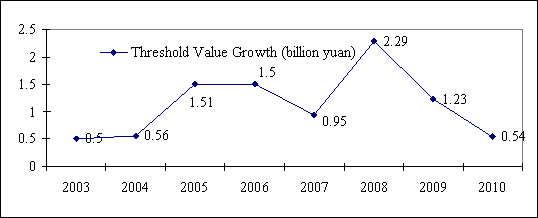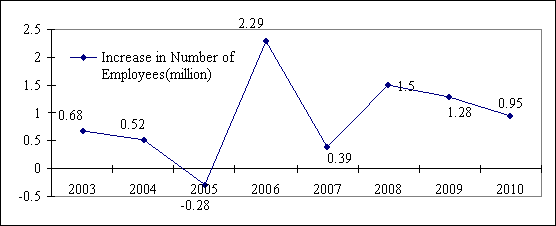X. Progress and Achievements of China's Large Companies amid Global Financial Crisis
2.2 The threshold for the Top 500 continued to be raised, but at a slower pace.
In 2002, the China Enterprise Confederation ranked the Top 500 Companies of China for the first time. Since then, the threshold for the Top 500 has continued to rise, from 2 billion yuan in 2002 to 11 billion yuan in 2010; however, the threshold has seen slower growth since 2008 (See Figure 1-8). Compared with the previous year, the threshold rose by 2.29 billion yuan in 2008; then, 1.23 billion yuan in 2009; and further, 0.54 billion yuan in 2010.

Figure 1-8. Threshold value growth for the Top 500 Companies of China (2003-2010)
2.3 Revenue growth slowed down sharply.
Similarly, the Top 500 Companies of China have seen slower revenue growth since 2008 (See Figure 1-9). The revenue of China's Top 500 Companies in 2010 only increased by 1.6 trillion yuan, 2.57 trillion yuan less than that in 2009 (4.17 trillion yuan) , the slowest growth since 2004.

Figure 1-9. Revenue growth of the Top 500 Companies of China (2003-2010)
2.4 Growth in hiring has slowed in the past two years.
In 2009, the total number of employees for the Top 500 Companies of China was 27.02 million, 0.95 million more than that in 2008 (26.07 million), however, the growth in new employment has declined in the past two years.

Figure 1-10. Increase in number of employees for the Top 500 Companies of China (2003-2010)
2.5 Overseas revenue decreased.
Due to the global financial crisis, companies have seen decreasing overseas revenues. In 2009, the Top 500 Companies of China earned a total overseas revenue of 2,504.783 billion yuan, down 3.42 percent from 2008 (2,593.568 billion yuan). Overseas revenue earned by state-owned companies dropped by 70.487 billion yuan, down 3.1 percent from the previous year. For central state-owned companies, overseas revenue decreased by 21.669 billion yuan, down 1.21 percent from the previous year.
Private companies suffered a harder hit amid the financial crisis. In 2009, the overseas revenue of private companies accounted for just 11.96 percent of the total revenue of the Top 500; however, private firms saw the biggest decline of their overseas revenues, at 5.76 percent over the previous year.
Table 1-25. Overseas revenue of the Top 500 Companies of China in 2010 classified by ownership
(Unit: bln yuan, percent)
|
|
Overseas Revenue in 2009 |
Overseas Revenue in 2008 |
Overseas Revenue Growth |
Growth Rate |
|
Top 500 |
2,504.783 |
2,593.568 |
-88.785 |
-3.42% |
|
State-owned |
2,205.306 |
2,275.793 |
-70.487 |
-3.10% |
|
Central State-owned |
1,783.512 |
1,805.181 |
-21.669 |
-1.21% |
|
Private |
299.477 |
317.775 |
-18.298 |
-5.76% |
3. China's large companies showed a forward-looking vision and remained sensitive to the market amid the financial crisis.
3.1 Private entrepreneurs hold better judgment on the market.
Even before the financial crisis, private entrepreneurs paid much attention to macroeconomic conditions. They analyzed changing market demand for their own products or services to learn of impending changes in the international market. Economists, management scientists and financial experts were invited to participate in studies of the global economic situation as well as China's national macro-economy, evaluate the developing trends in their industries, refine operating processes, and train senior managers and technical staff. In face of the financial crisis, a large number of companies even took brave measures to "go out" and carry on mergers and reorganization throughout the world. These indicators show that China's private entrepreneurs have become more and more mature, and China's private companies have become increasingly well regulated.
3.2 China's large companies took opportunities to make strategic acquisitions.
Undoubtedly, many foreign companies faced financial difficulties or even went bankrupt due to the global financial crisis, so the post-recession period was a good time for "bottom fishing". Many of China's large companies, including state-owned and private-owned firms, made judgment calls on the global economic situation and decided to "go out" at the proper time. Firms generally sought acquisitions in the following areas:
Firstly, firms sought high-quality overseas assets. Such assets include scarce natural resources such as petroleum, iron ore, coal and non-ferrous metals. Such overseas companies have been mainly acquired by central state-owned companies.
Secondly, Chinese firms sought to acquire premium brands. During the global financial crisis, the automobile companies in western countries suffered quite a hard hit. Facing financial difficulties, some European or American auto giants needed to sell off parts of their brands. Meanwhile, China's auto companies, lacking of self-owned or well-known brands for a long time, were quite eager to acquire these world famous brands. Geely Holding Group's acquisition of Ford Motor Co's Volvo unit and Beijing Automobile Works' purchase of several models from Swedish Saab are very good examples of this acquisition type.
Thirdly, Chinese firms have sought to acquire intellectual property. For Chinese companies who sought foreign acquisitions, their aim is not only to expand the scale, but also to bring in advanced technology, management, and research and development assets. This is the most important mission for firms to innovate and promote their self-owned brands in the international market. Hence, during the global financial crisis, Chinese companies attached much importance to the acquisition of intellectual property, particularly when purchasing high-quality assets and brands.
Finally, Chinese firms sought overseas talent. This is a new phenomenon for some of China's big companies, such as auto and financial companies. During the global financial crisis, a large number of talented overseas professionals have been attracted to carry out foreign acquisitions and manage assets or subsidiaries.
3.3 China's large companies actively adjusted their industrial structure and attached importance to the development of emerging industries.
In the post-crisis era, developed countries gave priority to the development of emerging industries of strategic importance in order to fight the crisis and boost economic growth. For example, they used research and development of green energy as a key to economic recovery. Considering this, they took the initiative to speed up tri-network integration (telecommunications, television and the Internet) to provide more support for development of biotechnology and explore new energy sources.
Through this financial crisis, China's large companies also realized that it's hard to a higher level of industrial maturity if the current growth model continues. Hence, with the support of governmental policies, they have actively adjusted their industrial structures and focused attention on emerging industries of strategic importance. So far, large firms have made great achievements in the areas of alternative energy vehicles, bio-fuels and clean energy technology.
|
Summary |
|
|
Chapter I. |
|
|
Chapter II. |
|
|
Chapter III. |
|
|
Chapter IV. |
|
|
Chapter V. |
|
|
Chapter VI. |
|
|
Chapter VII. |
|
|
Chapter VIII. |
|
|
Chapter IX. |
|
|
Chapter XI. |
 0
0 






